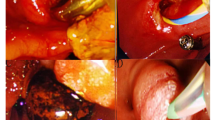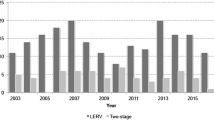Abstract
Background
There are a variety of strategies for the treatment of patients with cholecysto-choledocholithiasis (CCL). Although the surgical approach of choice is preoperative ERCP and laparoscopic cholecystectomy (ERCP + LC), controversy remains regarding which procedure is optimal for CCL.
Methods
To evaluate the safety and effectiveness of laparoendoscopic rendezvous (LERV) versus ERCP + LC for CCL, a total of 528 patients with CCL were retrospectively studied from January 2013 to December 2018. The patients were scheduled to undergo either the LERV or ERCP + LC procedure. The LERV group included 123 cases, whereas the ERCP + LC group contained 137 cases. The incidence of postoperative complications, success of stone clearance, length of hospital stay, and hospitalization charges were statistically analyzed.
Results
The incidence of pancreatitis was lower in the LERV group than in the ERCP + LC group (3/123 vs. 12/137, P = 0.0291). The median level of post-ERCP amylase was much lower in the LERV group (202.5 U/dL vs. 328.1 U/dL, P < 0.01). However, there was no significant difference in the stone clearance rate or other early complications between the two groups. Further study showed that the length of hospital stay and cost in the LERV group were less than those in the ERCP + LC group (12 days vs. 18 days, P < 0.01; 53591.4¥ vs. 60089.2¥, P < 0.01). In addition, more patients in the two-stage procedure group experienced later biliary complications compared with those in the one-stage approach group (34/137 vs. 4/123, P < 0.05). However, the median operation time was 107.7 min in the two-stage group and 139.8 min in the one-stage group (P < 0.05).
Conclusions
The LERV technique is a safe and effective approach for CCL with lower pancreatitis; it was associated with few later biliary complications, shortened hospital stays, and fewer charges but significantly longer operative time.

Similar content being viewed by others
References
Dasari BV, Tan CJ, Gurusamy KS, Bobby VMD, Chuan JT, Kurinchi SG, David JM, Gareth K, Lloyd MK, Tom D, Mark AT (2013) Surgical versus endoscopic treatment of bile duct stones. Cochrane Database Syst Rev 8:CD003327
Prasson P, Bai X, Zhang Q, Liang T (2016) One-stage laproendoscopic procedure versus two-stage procedure in the management for gallstone disease and biliary duct calculi: a systemic review and meta-analysis. Surg Endosc 30:3582–3590
European Association for the Study of the Liver (EASL) (2016) EASL clinical practice guidelines on the prevention, diagnosis and treatment of gallstones. J Hepatol 65:146–181
Mine T, Morizane T, Kawaguchi Y, Akashi R, Hanada K, Ito T, Kanno A, Kida M, Miyagawa H, Yamaguchi T, Mayumi T, Takeyama Y, Shimosegawa T (2017) Clinical practice guideline for post-ERCP pancreatitis. J Gastroenterol 52:1013–1022
Nalankilli K, Kannuthurai S, Moss A (2016) A modern approach to ERCP: maintaining efficacy while optimising safety. Dig Endosc 28(Suppl 1):70–76
Enochsson L, Lindberg B, Swahn F, Arnelo U (2004) Intraoperative endoscopic retrograde cholangiopancreatography (ERCP) to remove common bile duct stones during routine laparoscopic cholecystectomy does not prolong hospitalization: a 2-year experience. Surg Endosc 18:367–371
Feretis C, Kalliakmanis B, Benakis P, Apostolids N (1994) Laparoscopic transcystic papillotomy under endoscopic control for bile duct stones. Endoscopy 26:697–700
Rábago LR, Vicente C, Soler F, Delgado M, Moral I, Guerra I, Castro JL, Quintanilla E, Romeo J, Llorente R, Vázquez Echarri J, Martínez-Veiga JL, Gea F (2006) Two-stage treatment with preoperative endoscopic retrograde cholangiopancreatography (ERCP) compared with single-stage treatment with intraoperative ERCP for patients with symptomatic cholelithiasis with possible choledocholithiasis. Endoscopy 38:779–786
Liverani A, Muroni M, Santi F, Neri T, Anastasio G, Moretti M, Favi F, Solinas L (2013) One-step laparoscopic and endoscopic treatment of gallbladder and common bile duct stones: our experience of the last 9 years in a retrospective study. Am Surg 79:1243–1247
Ricci C, Pagano N, Taffurelli G, Pacilio CA, Migliori M, Bazzoli F, Casadei R, Minni F (2018) Comparison of efficacy and safety of 4 combinations of laparoscopic and intraoperative techniques for management of gallstone disease with biliary duct calculi: a systematic review and network meta-analysis. JAMA Surg 1539:e181167
Vettoretto N, Arezzo A, Famiglietti F, Cirocchi R, Moja L, Morino M (2018) Laparoscopic-endoscopic rendezvous versus preoperative endoscopic sphincterotomy in people undergoing laparoscopic cholecystectomy for stones in the gallbladder and bile duct. Cochrane Database Syst Rev 4:CD010507
La BG, Gardini A, Cavargini E, Casadei A, Morgagni P, Bazzocchi F, D’Acapito F, Cavaliere D, Curti R, Tringali D, Cucchetti A, Ercolani G (2018) Laparoendoscopic rendezvous in the treatment of cholecysto-choledocholitiasis: a single series of 200 patients. Surg Endosc 32:3868–3873
Staritz M, Ewe K, Meyer BKH (1982) Endoscopic papillary dilatation, a possible alternative to endoscopic papillotomy. Lancet 1:1306–1307
Ding J, Li F, Zhu HY, Zhang XW (2015) Endoscopic treatment of difficult extrahepatic bile duct stones, EPBD or EST: an anatomic view. World J Gastrointest Endosc 7:274–277
Miscusi G, Gasparrini M, Petruzziello L, Taglienti D, Onorato M, Otti M, Montori J (1997) Endolaparoscopic ‘‘Rendez-vous’’ in the treatment of cholecystocholedochal calculosis. G Chir 18:655–657
Tzovaras G, Baloyiannis I, Zachari E, Symeonidis D, Zacharoulis D, Kapsoritakis A, Paroutoglou G, Potamianos S (2012) Laparoendoscopic rendezvous versus preoperative ERCP and laparoscopic cholecystectomy for the management of cholecysto-choledocholithiasis: interim analysis of a controlled randomized trial. Ann Surg 255:435–439
Gaetano LG, Francesco B, Maria S, Saverio L (2010) Simultaneous laparoendoscopic rendezvous for the treatment of cholecystocholedocholithiasis. Surg Endosc 24:769–780
Feng Q, Huang Y, Wang K, Yuan R, Xiong X, Wu L (2016) Laparoscopic transcystic common bile duct exploration: advantages over laparoscopic choledochotomy. PLoS ONE 11:e0162885
Gupta N (2016) Role of laparoscopic common bile duct exploration in the management of choledocholithiasis. World J Gastrointest Surg 8:376–381
Lu J, Cheng Y, Xiong XZ, Lin YX, Wu SJ, Cheng NS (2012) Two-stage vs single-stage management for concomitant gallstones and common bile duct stones. World J Gastroenterol 18:3156–3166
Martin DJ, Vernon DR, Toouli J (2006) Surgical versus endoscopic treatment of bile duct stones. Cochrane Database Syst Rev 2:CD003327
El-Geidie AA (2011) Laparoendoscopic management of concomitant gallbladder stones and common bile duct stones: what is the best technique? Surg Laparosc Endosc Percutan Tech 21:282–287
Cavina E, Franceschi M, Sidoti F, Goletti O, Buccianti P, Chiarugi M (1998) Laparo-endoscopic “rendezvous”: a new technique in the choledocholithiasis treatment. Hepatogastroenterology 45:1430–1435
Basso N, Pizzuto G, Surgo D, Materia A, Silecchia G, Fantini A, Fiocca F, Trentino P (1999) Laparoscopic cholecystectomy and intraoperative endoscopic sphincterotomy in the treatment of cholecysto-choledocholithiasis. Gastrointest Endosc 50:532–535
Pezzilli R, Romboli E, Campana D, Corinaldesi R (2002) Mechanisms involved in the onset of post-ERCP pancreatitis. JOP 3:162–168
Testoni PA (2002) Why the incidence of post-ERCP pancreatitis varies considerably? Factors affecting the diagnosis and the incidence of this complication. JOP 3:195–201
Testoni PA, Mariani A, Giussani A, Vailati C, Masci E, Macarri G, Ghezzo L, Familiari L, Giardullo N, Mutignani M, Lombardi G, Talamini G, Spadaccini A, Briglia R, Piazzi L; SEIFRED Group (2010) Risk factors for post-ERCP pancreatitis in high- and low-volume centers and among expert and non-expert operators: a prospective multicenter study. Am J Gastroenterol 105:1753–1761
Sugiyama M, Atomi Y (2002) Risk factors predictive of late complications after endoscopic sphincterotomy for bile duct stones: long-term (more than 10 years) follow-up study. Am J Gastroenterol 97:2763–2767
Bostanci EB, Ercan M, Ozer I, Teke Z, Parlak E, Akoglu M (2010) Timing of elective laparoscopic cholecystectomy after endoscopic retrograde cholangiopancreaticography with sphincterotomy: a prospective observational study of 308 patients. Langenbecks Arch Surg 395:661–666
Salman B, Yilmaz U, Kerem M, Bedirli A, Sare M, Sakrak O, Tatlicioglu E (2009) The timing of laparoscopic cholecystectomy after endoscopic retrograde cholangiopancreaticography in cholelithiasis coexisting with choledocholithiasis. J Hepatobiliary Pancreat Surg 16:832–836
Bove A, Di Renzo RM, Palone G, Testa D, Malerba V, Bongarzoni G (2018) Single-stage procedure for the treatment of cholecysto-choledocolithiasis: a surgical procedures review. Ther Clin Risk Manag 14:305–312
ElGeidie AA (2014) Single-session minimally invasive management of common bile duct stones. World J Gastroenterol 20:15144–15152
Odabasi M, Yildiz MK, Abuoglu HH, Eris C, Ozkan E, Gunay E, Aktekin A, Muftuoglu MT (2013) A modified Rendezvous ERCP technique in duodenal diverticulum. World J Gastrointest Endosc 5:568–573
Garbarini A, Reggio D, Arolfo S, Bruno M, Passera R, Catalano G, Barletti C, Salizzoni M, Morino M, Petruzzelli L, Arezzo A (2017) Cost analysis of laparoendoscopic rendezvous versus preoperative ERCP and laparoscopic cholecystectomy in the management of cholecystocholedocholithiasis. Surg Endosc 31:3291–3296
La GG, Pesce A, Vitale M, Mannino M, Di MF, Di BM, Lombardo R, Puleo S, Russello D, Latteri S (2017) Efficacy of the laparoendoscopic “rendezvous” to treat cholecystocholedocholithiasis in 210 consecutive patients: a single center experience. Surg Laparosc Endosc Percutan Tech 27:e48–e52
Erickson RA, Carlson B (1995) The role of endoscopic retrograde cholangiopancreatography in patients with laparoscopic cholecystectomies. Gastroenterology 109:252–263
Rogers SJ, Cello JP, Horn JK, Siperstein AE, Schecter WP, Campbell AR, Mackersie RC, Rodas A, Kreuwel HT, Harris HW (2010) Prospective randomized trial of LC + LCBDE vs ERCP/S + LC for common bile duct stone disease. Arch Surg 145:28–33
Lella F, Bagnolo F, Rebuffat C, Scalambra M, Bonassi U, Colombo E (2006) Use of the laparoscopic-endoscopic approach, the so-called “rendezvous” technique, in cholecystocholedocholithiasis: a valid method in cases with patient-related risk factors for post-ERCP pancreatitis. Surg Endosc 20:419–423
Gagner M (2010) Intra-operative sphincterotomy and ERCP for choledocholithiasis during laparoscopic cholecystectomy. Surgery 147:463
Mario M, Filippo B, Claudio M, Niccolò F, Riccardo R, Aldo G (2006) Preoperative endoscopic sphincterotomy versus laparoendoscopic rendezvous in patients with gallbladder and bile duct stones. Ann Surg 244:889–893
Acknowledgements
The authors thank Quanyan Liu, MD, and Dingyu Pan, MD, from the Department of Hepato-Biliary Pancreatic Surgery, Zhongnan Hospital of Wuhan University, for their language and technical help and they also thank Hongling Wang, MD, from the Department of Gastroenterology, Zhongnan Hospital of Wuhan University, for preoperative ERCP.
Funding
This study was supported by grants from the National Natural Science Foundation of China (Grant No. 81802442).
Author information
Authors and Affiliations
Corresponding author
Ethics declarations
Disclosures
Yawei Qian, Jianglin Xie, Ping Jiang, Yuchun Yin, and Quan Sun have no conflicts of interest or financial ties to disclose.
Additional information
Publisher's Note
Springer Nature remains neutral with regard to jurisdictional claims in published maps and institutional affiliations.
Rights and permissions
About this article
Cite this article
Qian, Y., Xie, J., Jiang, P. et al. Laparoendoscopic rendezvous versus ERCP followed by laparoscopic cholecystectomy for the management of cholecysto-choledocholithiasis: a retrospectively cohort study. Surg Endosc 34, 2483–2489 (2020). https://doi.org/10.1007/s00464-019-07051-y
Received:
Accepted:
Published:
Issue Date:
DOI: https://doi.org/10.1007/s00464-019-07051-y




